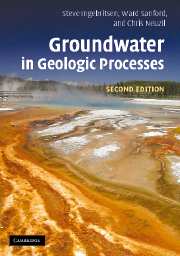Book contents
- Frontmatter
- Contents
- Preface
- Acknowledgements
- List of symbols
- 1 Groundwater flow
- 2 Hydromechanical coupling
- 3 Solute transport
- 4 Heat transport
- 5 Regional-scale flow and transport
- 6 Ore deposits
- 7 Hydrocarbons
- 8 Geothermal processes
- 9 Earthquakes
- 10 Evaporites
- 11 Compaction and diagenesis
- 12 Metamorphism
- 13 Subsea hydrogeology
- References
- Index
11 - Compaction and diagenesis
Published online by Cambridge University Press: 12 January 2023
- Frontmatter
- Contents
- Preface
- Acknowledgements
- List of symbols
- 1 Groundwater flow
- 2 Hydromechanical coupling
- 3 Solute transport
- 4 Heat transport
- 5 Regional-scale flow and transport
- 6 Ore deposits
- 7 Hydrocarbons
- 8 Geothermal processes
- 9 Earthquakes
- 10 Evaporites
- 11 Compaction and diagenesis
- 12 Metamorphism
- 13 Subsea hydrogeology
- References
- Index
Summary
In this chapter we discuss the role of groundwater in compaction and diagenesis. Compaction refers to the mechanical reduction in porosity that occurs in sedimentary sequences as they undergo depositional or tectonic loading and increases in effective stress. Diagenesis of sedimentary sequences refers to all of the chemical, physical, and biological changes undergone by a sediment after its initial deposition and during and after lithification, exclusive of weathering and metamorphism (Jackson, 1997). By this broad definition, diagenesis actually encompasses mechanical compaction, a process that we distinguish here for purposes of discussion: we discuss mechanical compaction in Section 11.1 and other forms of diagenesis in Section 11.2.
The distinction between weathering, diagenesis, and metamorphism, though variously defined, generally reflects increasing pressure– temperature (P–T) conditions. Weathering occurs at P–T conditions at or very near ambient surface conditions. By this definition, weathering includes karst development, which usually entails carbonate dissolution by groundwater at near-ambient conditions (e.g., White, 1988; Higgins and Coates, 1990; American Geological Institute, 2001; Culver and White, 2004). Diagenesis involves P–T conditions significantly in excess of ambient surface conditions. It can be considered to be bounded on the high P–T side by the lowest grade of metamorphism, as defined by specific mineral transformations (e.g., Weaver and Broekstra, 1984). Apart from a brief discussion of supergene enrichment of porphyry copper deposits (Section 6.4.1),weathering is beyond the scope of this book. We discuss metamorphism in detail in Chapter 12.
In this chapter, we will first focus on the mechanical processes that lead to sediment compaction and on the degree of compaction that can be expected with depth for various lithologies and environmental conditions. We will then focus on the role of groundwater in other forms of diagenesis: at the regional scale in sedimentary basins, in the mechanochemical process of pressure solution, and finally at the local scale of mineral banding. The scope of this chapter is generally restricted to sedimentary-basin environments. Elsewhere we discuss the specific case of compaction in the Gulf Coast basin (Section 5.2.4), deformation and diagenesis within accretionary prisms (Section 13.7), and the diagenesis of carbonate platforms in shallow marine environments (Sections 13.8.1 and 13.8.2).
- Type
- Chapter
- Information
- Groundwater in Geologic Processes , pp. 352 - 384Publisher: Cambridge University PressPrint publication year: 2006

